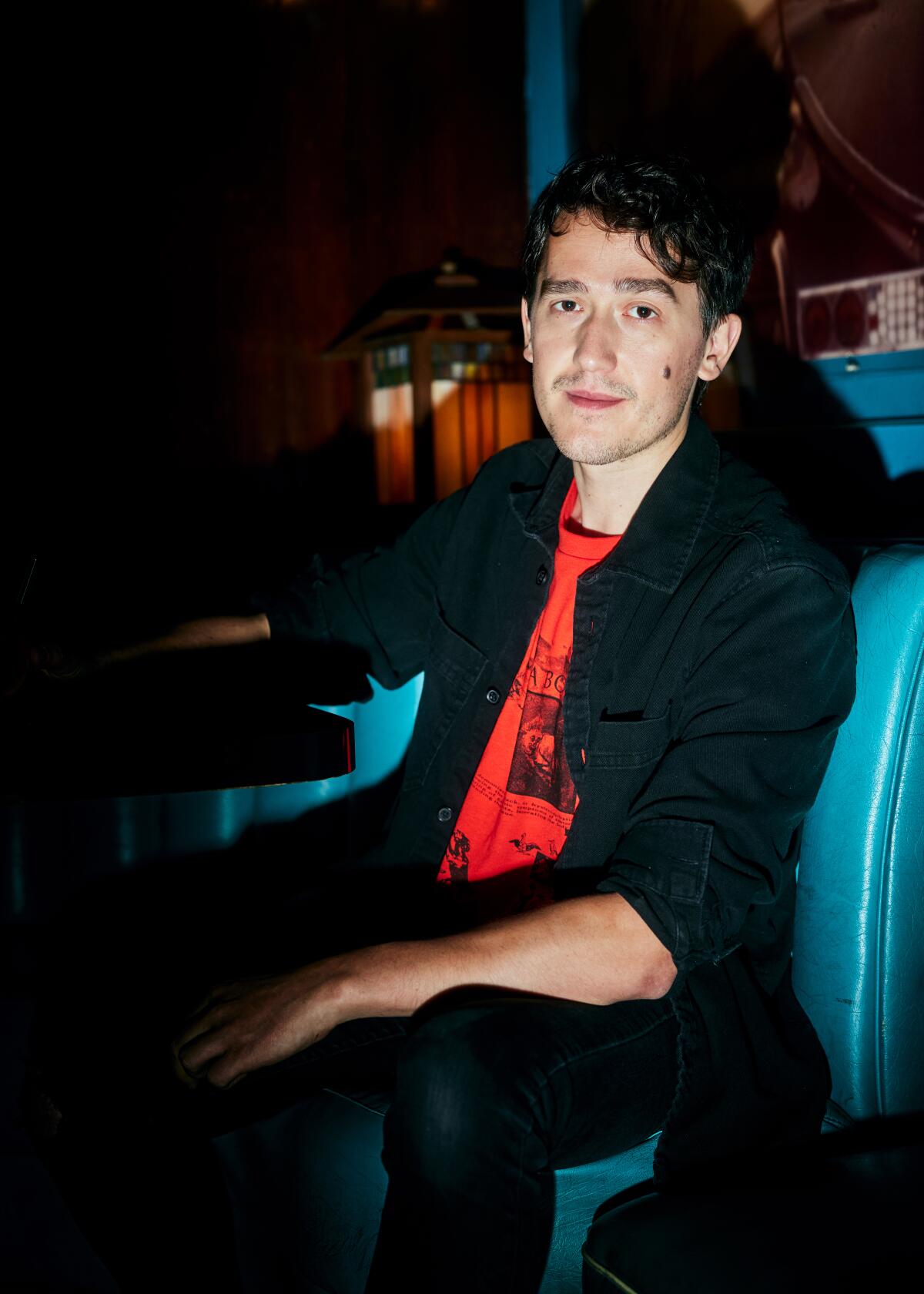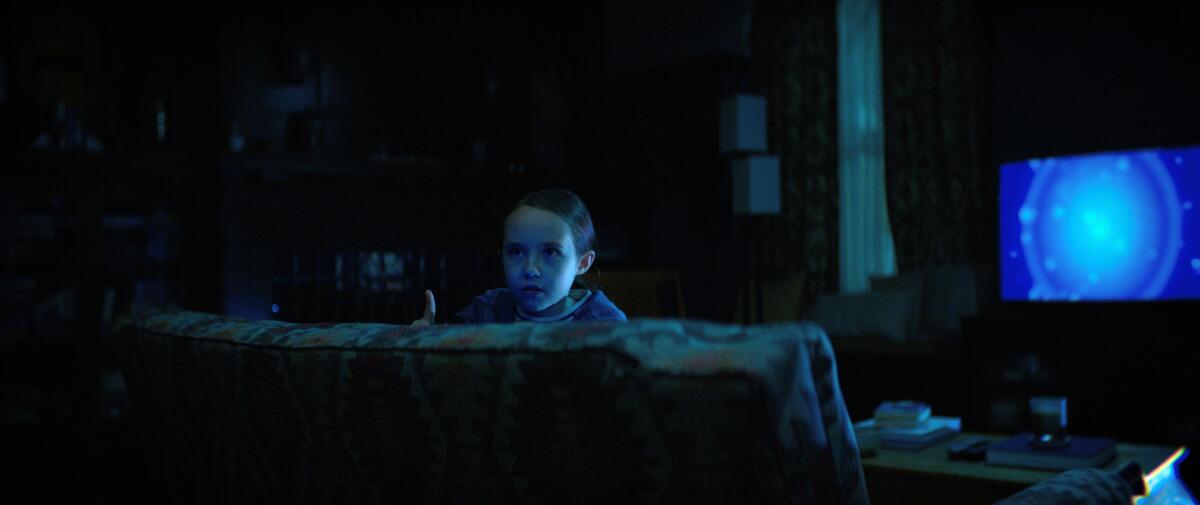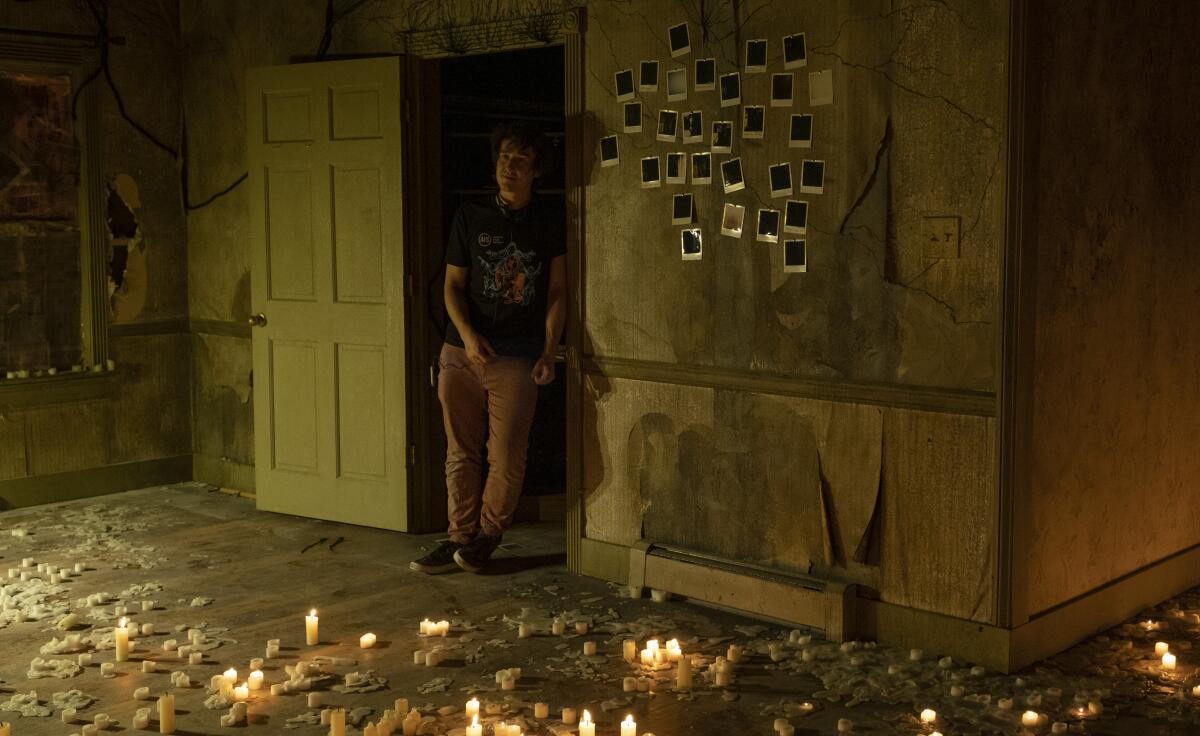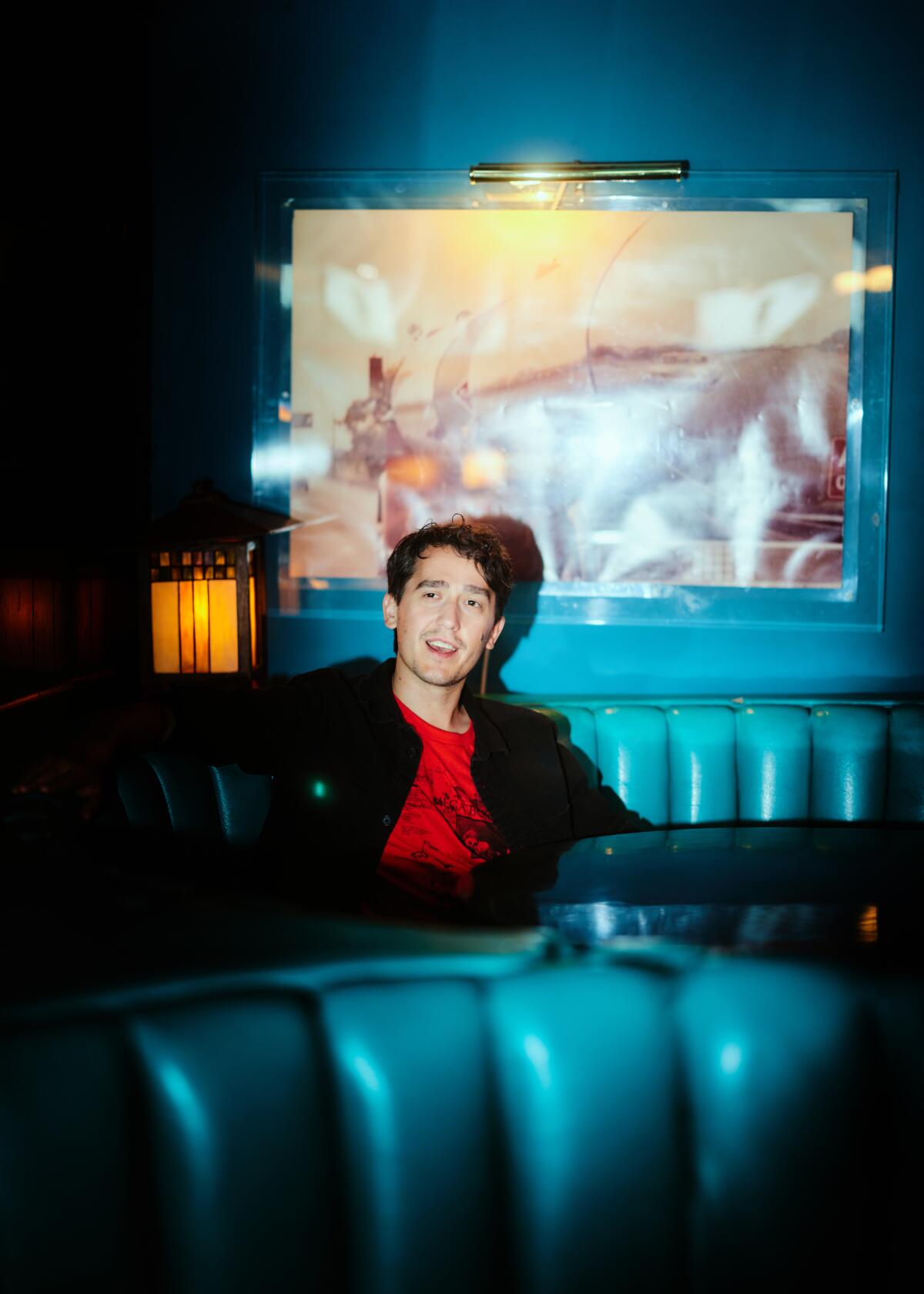Only good movies
Get the Indie Focus newsletter, Mark Olsen's weekly guide to the world of cinema.
You may occasionally receive promotional content from the Los Angeles Times.

Hours before hopping a red-eye from Los Angeles to London to promote the biggest film of his career, one of horror’s fastest-rising filmmakers is too busy waxing ecstatic over his love of scary movies to worry about making it to the airport on time.
Why horror? Let “The Boogeyman” director Rob Savage count the ways. “There are taboo things that we all think and feel that we don’t want to talk about, that in a horror movie you can dramatize without looking straight in the eyes,” he says, sipping an old-fashioned at the aptly named Blue Room, one of his favorite Burbank bars.
In conversation, he ticks off his favorite auteurs — De Palma, Argento, Bava, Hitchcock — with encyclopedic knowledge, recounting how his cinematic obsessions led him to experiment with tricks and techniques, and resulted in at least one black eye. (It came from a falling camera, while re-creating the stair shot from “Psycho.”) But Savage‘s love affair with the genre is an emotional one too.
“The best horror movies make me feel really seen,” he smiles. In his youth, he aspired to be the next Lynne Ramsay or Andrea Arnold. Now he’s eager to play in as many horror sandboxes as he can before “AI is directing everything.”

It tracks, then, that the 30-year-old British writer-director landed on Hollywood’s radar by peering darkly through that same lens, finding fresh ways into found footage while tapping into raw pandemic-era anxieties with 2020’s Zoom seance-gone-wrong hit “Host” and 2021’s provocative shutdown pic “Dashcam.”
Now, with his third horror film in three years, Savage tackles one of humanity’s most universal themes: grief. Opening Friday, Stephen King adaptation “The Boogeyman,” his studio directing debut, finds Sadie (Sophie Thatcher) and Sawyer (Vivien Lyra Blair), daughters of therapist Will Harper (Chris Messina), plagued by a sinister force while mourning the recent death of their mother.
The film is right and tight. I’m delighted with it.
— “The Boogeyman” author Stephen King
King’s original tale zeroed in on two characters, a therapist and his patient haunted by an evil presence he blames for the mysterious deaths of his young children. Reworking an initial script by “A Quiet Place” writers Scott Beck and Bryan Woods that expanded the story into a domestic saga, Savage and “Black Swan” scribe Mark Heyman shifted it to rest on the shoulders of teenage Sadie, who battles her angst and anguish to save her broken family.
“My story is in the first 10 or 15 minutes of Rob’s extraordinary movie — a kind of prologue,” King told The Times in an email. “It’s a very short story, originally published in ‘Cavalier’ magazine, a long time ago, and their word-count requirements were ironbound — they had to have plenty of room for cheesecake photos. I think they paid me maybe $400. Rob and the crack writing team expanded on it with great success. The family dynamic they created would have been beyond me at age 24. The film is right and tight. I’m delighted with it.”

Previously set for a Hulu streaming debut before pivoting to a 20th Century theatrical release — in part thanks to King, who gave the studio a helpful nudge of approval after watching the film, Savage notes — “The Boogeyman” is a classically wrought domestic nightmare that plays out in shadows and light, in the liminal terrors of a creaky Craftsman engulfed in heavy silences.
But don’t lump it into a trend of “grief horror,” Savage pleads, preempting comparisons to the likes of Jennifer Kent’s 2014 “The Babadook.” “To me the horror in this movie, the Boogeyman and everything that it represents, is more about communication,” he says. “It’s about leaning on people when you’re going through times of darkness. It is about grief, but it’s also about how scary it is to be open, especially when you’re speaking to something that’s very dark and exposing.”
Pop culture is in the midst of a full-on Stephen King boom. Again.
With a reported $35-million budget, familiar genre bones and a PG-13 rating, “The Boogeyman” may seem the antithesis of the scrappily inventive and sharp-edged, low-budget films that launched Savage’s career. But he’s been hustling to break into the movie business since making his first feature for $3,000, a teen drama that won him a British Independent Film Award at age 17.
“I’ve always wanted to make a movie like this — a classic roller coaster ride, a Friday night popcorn horror movie that plays to a big crowd,” says Savage, whose upcoming projects, including a collaboration with Sam Raimi, have him poised for a big future in mainstream horror. “That’s been more my dream than making, like, ‘Hereditary’ or an A24 movie. I’ve always wanted to make something that plays like ‘The Conjuring.’”

Rewind to the start of Savage’s origin story and you’ll find yourself in verdant, rural Shropshire, England, near the Welsh border. There, where Charles Darwin was born nearly two centuries prior, the self-described young gorehound grew up around the family farm with “hippie-dippie vegan” parents who strictly banned sugar, television and the horror movies that called to him like forbidden fruit.
“The only thing I wanted to do was watch the bloodiest, nastiest movies I could get my hands on,” says Savage. “That became my odyssey — I wanted to eat McDonald’s, drink SunnyD and watch ‘The Texas Chain Saw Massacre.’”
Unbeknownst to his parents, he procured a portable combo VCR-TV and collected VHS tapes from yard sales and charity shops, especially keen on the video nasties of the ’80s — and hid his precious stash with stealthy invention. “I had VHS tapes in a plastic bag with a bit of string and a pulley system, and I’d hide them in the walls of my house like ‘The People Under the Stairs,’” he grins. “I’d work my way through every time my parents would leave the house.”
He’d play the movies on mute when everyone else was asleep, consuming them as “these weird nightmare images” that burned themselves into his image-oriented psyche. “I remember watching ‘Hellraiser’ with no sound the first time, and it made me feel delirious,” says Savage. “Even now, some of my favorite movies I love to watch with no sound on, to see how they are put together visually.”
In the end, his dad relented and showed him the movie that would inspire him to make his own: Katsuhiro Otomo’s 1988 cyberpunk anime “Akira,” a seminal classic “full of body horror and murderous biker gangs,” says Savage. The onetime aspiring comic book artist’s brain exploded. “And then I started seeing everything moving.”


Years later, after moving to London and working on music videos, shorts and commercials to prove his chops, he began his indie breakout “Host” with a stroke of isolation ingenuity in the early days of the pandemic. Regular Zoom hangouts with friends inspired the filmmaker to prank his buddies with a haunted attic stunt that went viral — and got the attention of streaming platform Shudder, which gave Savage a tiny budget to turn it into a feature film.
“‘Host’ literally saved my life during the lockdown,” he says of the uniquely of-the-moment quarantine chiller, told through virtual screens with actors filming in their homes. “It gave us purpose during those long months.” Released in July 2020, it drew critical raves and nabbed Savage a three-picture Blumhouse deal, even if the celebration was surreal: “I felt very distant from all the fanfare because I was still in my house in my pajamas, sitting on Zooms.”
Horror movies have always had a dedicated fan base. But as other genres lose their power, scary films have become a much-needed hotbed of creativity and commercial power.
Within six months he was already shooting “Dashcam” for Blumhouse, centered on a polarizing livestreamer (musician Annie Hardy, playing a version of herself) caught up in sinister happenings during COVID shutdowns. Filmed in late 2020, it wouldn’t be released until 2022 after a film festival run, and by the time it hit theaters its radioactive lead proved a hard pill for some viewers to swallow. The movie landed with a thud.
“The interesting thing about the room is that you’ve got to imagine the room a year from now when you’re making a movie — especially for a movie that’s really trying to take the temperature of what’s going on right now,” Savage says in hindsight. “It was before the conversation around vaccines got so heated and vitriolic. It was made in the spirit of, ‘Everyone’s outside again. Let’s take the piss out of the last few months.’”
He pauses, a bit wistful. “It would have been nice if that movie had got a bit more of a life. It fizzled a little bit, but it was OK because I see that and ‘Host’ almost as a package deal,” he says. Years down the line, he imagines, audiences will have enough distance to revisit it. “It will sit in my filmography, and people will hopefully lighten up a bit and have fun with it.”

“Dashcam” was a tough lesson, but one Savage barely had time to process before he got off social media and flew to New Orleans to film “The Boogeyman.” His initial pitch to producer 21 Laps (“Stranger Things”) had been simple — “‘Poltergeist’ meets ‘Ordinary People.’” It was the latter reference to Robert Redford’s Oscar-winning 1980 familial grief drama that intrigued actor Sophie Thatcher.
Thatcher was initially hesitant to take on another genre project during her hiatus from hit series “Yellowjackets.” Then she and Savage bonded over their mutual cinephilia in their first virtual meetings, trading references to such works as Nicolas Roeg’s “Don’t Look Now,” discovering they owned matching “Betty Blue” posters and diving into the characters they’d need to keep grounded for the film to work.
“He was self-aware that this movie being about the Boogeyman, we’re dealing with something that is very well-known,” says Thatcher. “His ultimate [goal] was to not make it corny and make it as artful as possible.”
During production in New Orleans, Savage would jump in to play scene partner to his cast when they had to act opposite their titular computer-generated co-star, acting out the Boogeyman’s menacing noises and mannerisms. “He was so invested,” says Thatcher. But on set Savage also found himself processing the film’s themes in an intimately personal way when they hit unexpectedly close to home.

“I’d just gone through a loss before we did this movie. And it was a nice thing to be able to put words to those oddly specific feelings,” he says, specifying only that it was a death in the family back home in the U.K. “When you lose someone, it doesn’t happen all at once; that person dies lots of little deaths. At the beginning of the movie, the mom is kind of alive — you’ve got [her painting] studio and all the light is pouring in and her portrait is half finished and the paint is still wet. She’s still a presence in the house. And then she dies again when you box her up and put her into the dark basement, and she dies again every time you avoid the conversation with your family members. And it was kind of the same with my family.”
He says it again: “The Boogeyman” is not an A24 movie. “It’s not a grief movie in that way. But the scenes that have to do with that are really heartfelt. Nothing in this movie, surprisingly for a Disney movie called ‘The Boogeyman,’ was done cynically.”
Horror, he says, is the most “empathetic” of genres, peeling back his philosophical approach to scary movies. “Horror can put you shoulder to shoulder with characters that you would cross the street to avoid, but in that context you’re rooting for them. You come to understand them. And it’s a good leveler. ... If somebody is in a life-or-death situation, none of the other bull— is important anymore.”
Only good movies
Get the Indie Focus newsletter, Mark Olsen's weekly guide to the world of cinema.
You may occasionally receive promotional content from the Los Angeles Times.